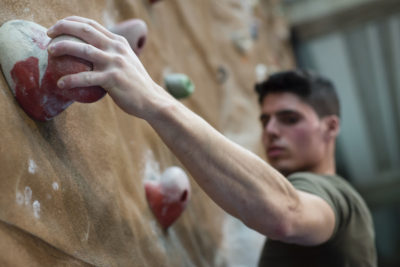There are many ways to improve bouldering skills that don’t require long intensive workouts. Most of the following tips can be incorporated into regular bouldering sessions.
Improve your bouldering skills by practicing static moves, with a focus on developing accurate footwork. Learn and practice moves which help steady unstable positions, such as flagging. Gain familiarity with dynos by working static problems using a dynamic approach. Practice easy routes repeatedly, using technical precision, to fuse muscle memory with good habits. Challenging problems should also be repeated to lock in your improvements.
Remember to check in with your physician or a registered training professional before starting on a training plan.
Improve Static Moves
Static movements are deliberate, and can be stopped and reversed because there is constant contact with holds. Static moves rely on muscle control, precision, balance and correct body positioning.
Balance and footwork are especially important in static climbing.
Central Rock Gym has a very useful video with Stephen Bryant covering footwork. Access by clicking here. The video is about 12 minutes, and well worth the time. Stephen covers:
- Which part of the foot/shoe to use and why: because resting one’s weight on the toes allows pivoting on the hold, one should focus on using the toes, the rest of the foot not so much.
- Balance and creating a solid base (or “removing the swing”): feet far apart gives more stable support and better balance. Having the feet close together, for example having both feet on the same hold, is more likely to lead to swinging off the wall.
- If the feet are close together, provide stability by having the hands far apart.
- Flagging: the move prevents barndooring by redistributing the weight; place one leg behind the other and touch the toes to the wall for support. Flagging takes the weight off one of the hands, to allow moving on to another handhold. The video demonstrates flagging at 6 minutes.
- Rely on good footwork, and not on arm strength: relying mostly on the arms for drive and momentum causes early fatigue.
- At 10 minutes, Stephen provides a foot drill guaranteed to work the core – I’ve been doing this on a wall similar to the one he is using, and can vouch that it’s quite the workout!
A strong core improves overall balance by making it easier to shift one’s weight. A strong core ties together upper and lower body strength and allows more control over hip positioning. Besides the foot drill demonstrated at the end of the video, doing problems with a lot of slopers is another good way to work on this because slopers absolutely require core engagement.
Here‘s a quick 3-minute video by Hugo Hornshaw, a young Australian competition climber, showing exercises that target the core muscles most needed in climbing. The three exercises, Toes to Bar, Windscreen Wipers, and Front Lever, can all be done on a chin-up bar.
The muscles on the back of the body are also an important part of core strength. It is important to have front and back muscles evenly strong to maintain balanced posture and prevent injury. In addition to the exercises in Hugo’s video, Eric Horst provides one more for the back muscles. See the Superman exercise at 3:30 minutes in the Epic TV video here on Youtube.
Improve Dynamic Movements
Dynamic moves rely chiefly on the legs for upwards or sideways thrust. For a solid launching base, use the largest footholds available for the move.
To get started with dynamic movement, find easy problems that you have already sent using a static approach, and redo the problem with a more dynamic mindset. To turn a static problem into dynamic practice, skip over handholds within easy reach, and instead reach out for more distant holds with a push from the hips and legs. Check out Power Company Climbing’s 57 second video to get the gist.
This type of practice could be done as part of warmup at the start of each bouldering session.
Improve Training
Everyone seems to agree that bouldering is the best training for bouldering, but there’s no benefit to repeating bad technique. It’s important to do this practice with mindfulness and correct technique. A sloppy approach definitely won’t lead to improvement. Likewise, repeatedly doing difficult problems before being ready for them can form bad muscle memory habits that will be hard to reverse.
Repeat Easy Problems
To expand your toolbox of well-practiced, mastered moves:
- Fuse muscle memory to excellent performance by practicing the same routes over and over, in the most technically correct way possible.
- If you hit a plateau with several months of no improvement, consider hiring a coach to cover the basics of technique, posture, balance, weight shifting, and hand and foot placement.
Repeat easier problems that have a variety of holds to build up a basic arsenal of confident moves. For example, Shauna Coxsey, IFSC Bouldering World Cup Champion, regularly starts her sessions with easy, basic circuits that allow her to focus on precise hand and foot placement (1).
Repeat Challenging Problems
Climber Jonathan Siegrist recommends repeating difficult problems in order to go up in grades. Work through a problem that truly tests your limits, then do it again to lock in improvements. When you reach the point where it only takes one or two tries to send a certain grade, Jonathan advises that this is a good time to move on to the next level.
Increase the Scope of What’s Familiar
Try going outdoors! The wonderful diversity of problems found in outdoor bouldering is a great way to expand skills and gain confidence. Watch advanced climbers of your own height and body type, see how they handle new obstacles.
Closing Thoughts on Training
Bouldering experts say to always start bouldering sessions with a warmup, to prevent injury and improve performance.
It takes at least a year or more for tendons to adapt to the new demands of bouldering, so when starting out it’s a good idea to postpone intensive training. Before trying out fingerboards and campus boards, check with a trainer to make sure your body is ready for this level of all-out demand.
Improving Strategy
Strategy is the practice of studying a problem before starting the climb. There are several ways to upgrade strategy in bouldering:
- When studying the problem, stand back far enough to have an accurate view of holds and route structure. When standing too close, it is harder to see how far apart the holds actually are to each other, and to get an accurate picture of the wall’s configurations.
- Make a habit of planning out every problem, not just the difficult ones, so that working out beta becomes second-nature. Eventually this will lead to greater overall efficiency on problems.
- Have a backup strategy in case the first one fails you halfway up the wall.
- Consider how you will get back down before committing to going up.
John Sherman in his book Better Bouldering recommends mentally reviewing the proposed beta move by move, and hold by hold, considering where hands and feet will go. Visualize how weight will shift, and how this will impact stability. Can flagging be used to prevent swinging off the wall on reachy moves? Look at the footholds as well as the handholds, and plan out how you will generate the thrust if dynos are needed.
Use Downclimbing to Practice Different Beta
Instead of simply jumping down after sending a problem, keep in mind that downclimbing doubles your time on the wall. It’s a great opportunity to practice different beta than what you will have used in climbing upwards.
Coming back down can be done by using the same route used on the way up, so when studying the problem consider how the holds can be used in reverse. It can also be done using the route’s downclimb if there is one, or simply jumping onto the padding if the problem is low to the ground. For tips on jumping down, see my article, How Does One Jump Down Safely from a Bouldering Wall?
Improve the Mental Aspect
One’s mental state when on the wall is important for performance. 2017 World Cup Bouldering Champion Shauna Coxsey affirms that “To win, you have to be in control of your mind even more than your body.” John Sherman in his book Better Bouldering tells us that bouldering is more mental than muscle.
Breathing: Quick and Easy Way to Mental Control
Breathing patterns have a big impact on mental state. Slow deep breaths are almost instantly calming. Take about 6 breaths per minute, with the belly bulging out when breathing in. A few slow deep breaths before getting on the wall helps clear the head, allowing the mind to focus. This is also useful on problem sections that require proceeding with care.
Too much tension causes excessive gripping, and this accelerates muscle fatigue. To release tension when on the wall, breathe slowly and deeply from the belly. Why breathing from the belly? Because a Harvard study confirmed that breathing only from the chest increases tension (2).
Also, if you find that you are holding your breath, release it and resume slow deep breathing. Deliberately relax the tense muscles, and clear your head. Focus only on body placement and holds.
Quick breaths, on the other hand, will psych you up for physically demanding and dynamic moves.
Build Self-Awareness
To keep us safe, the mind pre-sets limits on what is possible. These built-in restraints are below what we can actually achieve, and can be a block to great performance. Expand these limits by occasionally pushing exertion to the max: every once in a while, surprise yourself on what is possible by going all-out on a really tough problem.
Robert Scoverski, in Eric Horst’s book Learning to Climb Indoors, recommends increasing self-awareness to improve mental preparedness. Identifying one’s weaknesses is easier with the feedback of someone with experience. If you don’t have an advanced bouldering buddy, consider a bouldering coach to help with this, and to provide training strategies that address your particular problem areas. Robert recommends having a coaching session every 3-4 months, or even once a month, to keep the improvements rolling.
Sign up for an Intro Class to Bouldering
Taking an introductory class will impact mental preparedness. Besides providing an opportunity to meet other people new to the sport, getting training improves confidence and technique. Confidence in and of itself improves mental state. This in turn improves performance by reducing jitters on the wall.
However, if the jitters are mainly caused by height fright, see my article 3 Simple Ways to Control Fear of Heights in Bouldering.

